I’m always fascinated with ideas that do not disrupt the known laws of physics but imply an engineering so vast that it seems to defy practical deployment. Centauri Dreams readers are well aware by now of some of Robert Forward’s vast mental constructions, including lightsails in the hundreds of kilometers and enormous lenses in the outer Solar System as big as some US states. But such notions abound in the realm of interstellar thinking. Thus Clifford Singer’s ideas on pellet propulsion to a receding starship, which from the mathematical analysis require an accelerator 105 kilometers long, an engineering nightmare.
But then, when we reach sizes like these, we might ask ourselves whether we’re not overlooking the obvious. When Cornell’s Mason Peck went to work on wafer-scale spacecraft, one futuristic notion that occurred to him was to charge swarms of tiny ‘sprites’ through plasma interactions and use Jupiter’s magnetic field as a particle accelerator, pushing the chips to thousands of kilometers per second. That gets you to Proxima Centauri at, conceivably, a tenth of lightspeed. And instead of building a vast accelerator, you use the one the Solar System already has.
Columbia University’s David Kipping likewise investigates what we can do with natural objects. Years ago, he became fascinated with Claudio Maccone’s ideas for a FOCAL mission, which would use the Sun’s own mass as the instrument for ‘bending’ starlight to a focus at about 550 AU, one that might be exploited by future deep space telescopes. I put ‘bending’ in apostrophes because actually the light never bends, but flies straight and true through spacetime curved by the presence of mass. The Sun has 300,000 times the mass of the Earth, a useful object!
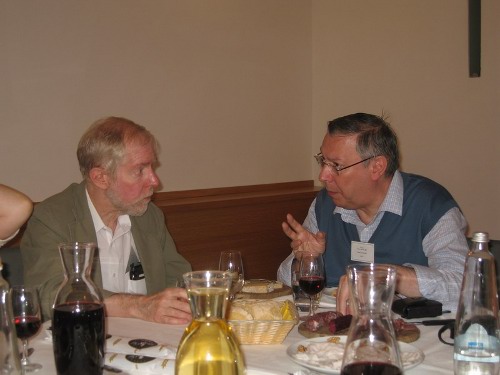
Image: Writing about Italian physicist Claudio Maccone gives me the chance to tap a favorite memory. Here I’m at the left, having lunch with Claudio ten years ago in the Italian Alps. This was one of many sessions in which Claudio helped me understand the implications of gravitational lensing. Credit: Roman Kezerashvili (City University of New York).
No one in the rich history of gravitational lensing concepts from Einstein through Von Eshleman and on to Maccone, Geoff Landis and Slava Turyshev has done more for the field than Maccone himself, having submitted a proposal to the European Space Agency for FOCAL as far back as 1993, and having authored the key text, Deep Space Flight and Communications: Exploiting the Sun as a Gravitational Lens (Springer/Praxis 2009).
A Lens the Size of the Earth
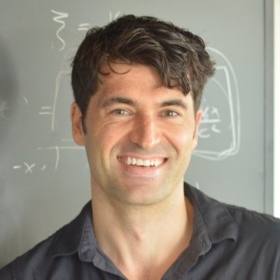
Of course, in our current stage of technological development, FOCAL itself is quite a reach, given our problems in getting to the outer Solar System — our farthest-flung craft even now are but a third of the way to where the lensing phenomenon could begin to be exploited. Well aware of this, David Kipping wondered if there wasn’t a way to explore the ‘bending’ of light in a different way, one that could help us learn how to untangle complex lensed images and develop near-term technologies at distances much closer to home. And it turns out there is, although it’s not a proposal that relies on gravitational lensing but rather the refraction of light.
Image: Columbia University physicist David Kipping.
Kipping wants us to consider the Earth as the source in a concept he calls the Terrascope. Although Maccone has considered the gravitational lensing properties of individual planets, the effect is small. Kipping reminds us that bending light through refraction has been used since the earliest telescopes. Refraction happens when light moves from a medium like air to a dense medium like glass. The result: Magnification as well as amplification, depending on the size of the lens.
The problem: Keep making larger and larger refracting telescopes and the lenses begin to deform under gravity. Reflector telescopes solve many of the problems of refractors, but we can see how far we’ve pushed their limits when we consider how we’ve had to move to segmented mirrors like the 36-mirror Gran Telescopio Canarias. Segmented mirrors cope with the deformation problems of a single large mirror but demand powerful computing resources. As their size continues to increase, costs skyrocket.
Kipping was originally inspired by the ‘Green Flash’ phenomenon that is the result of the refraction of the Sun’s light at sunset or sunrise. It lasts no more than a second or two, and appears because blue light is attenuated by scattering in the atmosphere as sunlight is spread into its constituent colors. The Columbia physicist, working thirteen years ago on a master’s thesis at Cambridge, realized that at a certain distance from Earth, if the Sun were directly behind our planet, a global green flash would appear, forming a green ring around Earth.
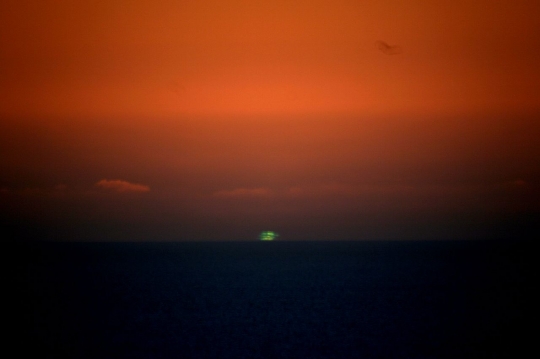
Image: The green flash as seen in Santa Cruz, VA. Credit: Brocken Inaglory CC BY-SA 3.0.
And what happens with more distant starlight? If the Earth is in front of a star, light from the star is deflected by the Earth’s atmosphere by about half a degree as it enters, and another half a degree as it exits — for those light rays that skim the surface. This sets up a focal point at a distance less than the Earth’s distance from the Moon. Even more significantly, a focal line is created as we consider light rays that enter the atmosphere higher up. Here the bending effect is somewhat less, but we also begin to mitigate atmospheric effects that would put noise in our data.
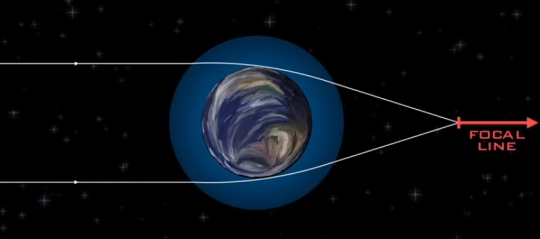
Image: Light from a distant star is deflected by the atmosphere of the Earth by half a degree. After skimming the surface, it is bent again as it exits the atmosphere by one-half a degree. Light entering the opposite hemisphere does the same, creating a focal point. Rays entering the atmosphere higher up bend less because the atmosphere is thinner with altitude, so the result is a focal line. The trick is knowing which light can be effectively sampled. Image credit: David Kipping.
As you can infer from the image above, light that skims the surface of the Earth would encounter too many obstacles to be helpful, but light rays encountering the atmosphere at higher altitudes can give us a focal point at the distance of the Moon. Even here, though, we run into scattering and extinction effects produced by the atmosphere, which depend upon the wavelength of the light we’re looking at.
Moreover, clouds are a factor, meaning we have to choose light that enters the atmosphere higher still. In his paper, Kpping argues that a detector placed at the Hill Sphere distance, about four times the distance between the Earth and the Moon, is positioned to intercept light that would have skimmed the Earth’s atmosphere at an altitude of 14 kilometers. As he notes in a recent email: “So put a detector at the Lagrange point, look back at the Earth, block out the disk of the Earth itself, and around the rim you should see light from distant stars lensed into ring-like structures.”
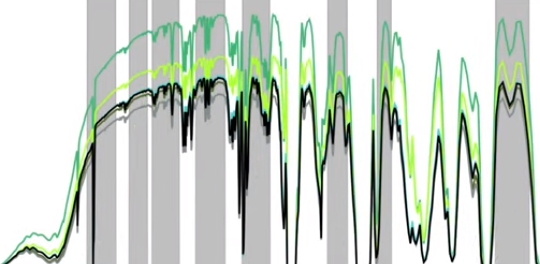
Image: Extinction effects for a terrascope at the Hill Sphere distance, roughly 4 Earth radii. Here, most of the infrared spectrum becomes usable for lensing. Image credit: David Kipping.
The Hill Sphere distance is benignly close compared to the gravitational lens at 550 AU, which means it offers an interesting observing possibility at a distance we’re experienced at reaching — the James Webb Space Telescope will work within this range. If we can truly exploit this phenomenon, we can get amplifications in the range of 22,500, Kipping estimates. This is actually a conservative estimate, but probably necessarily so, as he explains in his email:
“Now the Earth is much smaller than the Sun, so the amplification is not comparable with FOCAL but still impressive. I compute it is 45,000 after accounting for clouds and extinction losses, and is fairly wavelength independent beyond a micron (refraction doesn’t change much beyond 1micron). I think you might lose up to half of that due to half of the Earth being in daylight, which obviously would be a bright noise source. So removing that, I think 22,500 amplification is more realistic. That means you would turn a 1 meter detector into a ~150 meter effective aperture, amplifying sources by nearly 11 magnitudes.”
A one-meter detector analyzes light in a way that a 150-meter space telescope would otherwise be capable of, without, of course, the vast cost incurred by the latter (remember that even the JWST, a 6.5-meter instrument, has already incurred costs in the range of $10 billion).
But how would we use an effect that allowed us to look only at whatever happens to be behind the Earth during the observing period? I want to talk about this paper more tomorrow, and also alert you to Kipping’s video description of the idea. There are also obvious issues having to do with atmospheric effects and questions about occultation methods in this work. But there are enough serious advantages — we’ll look at several more tomorrow — to make us delve deeper.
The paper is Kipping, “The ‘Terrascope’: On the Possibility of Using the Earth as an Atmospheric Lens,” accepted at Proceedings of the Astronomical Society of the Pacific (abstract).



Welcome back Paul. Good to know that you are safe and sound despite the “incedent” at SagA. Dr Kipping’s Terrascope is amazing, but you should also check out his equally wild concept of “quasites” on a PREVIOUS “Cool World” video! I hope that you talk this one up, too, in a future post, but in the mean time, you may want to ask him if he thinks that the random transits Kepler(K2) observed at HD 139139 might be quasites gone horribly wrong.
Thanks, Harry. Will ask Dr. Kipping about quasites.
https://youtu.be/jxN–4BKH7g
Sounds like this could work with Jupiter as well.
It is neat that you could potentially have large numbers of telescopes orbiting and using the same planet as a lens. Each one observing a swath of the universe in each orbit.
Yes, Kipping talks about the possibilities of doing this with Jupiter.
A Dyson Shell would make for one heck of a telescope:
http://www.setileague.org/editor/monument.htm
Oh we could just polish half of Luna down to smooth glass. Ironically, this would “confirm” the Medieval idea that our Moon was a smooth mirror reflecting Earth.
Is Earth the best planet for this? Other than that it’s so close to where we live. But might not a world (planet or moon) farther from the sun, or one with fewer clouds work better?
That’s what I was wondering. A chilled hydrogen/methane atmosphere like Uranus or Neptune would have a distinct advantage. Transport issues mean the Terrascope is easier in the short term. But what about Venus? Above the clouds its atmosphere seems peaceful compared to Earth’s.
Welcome back Paul – and with a great article too!
Can’t wait for tomorrow’s one.
Glad to be back. Thanks!
David Kipping and his group have an excellent Youtube channel, CoolWorlds:
https://www.youtube.com/channel/UCGHZpIpAWJQ-Jy_CeCdXhMA
Can the moon be useful as a gravitational “bending” source as well? It has little or no atmosphere, its gravity well is presumably easier to “hover” over, it’s reachable with today technology.
Suppose we built fresnel refractors on the moon around its circumference when viewed from the point of the view of the sensor spacecraft. Incoming light is bent optically in a “lens” that is of lunar diameter.
Of course long exposures with this “telescope” require some tricky maneuvering :) . But that’s no different from using a star or a planet as a light bending mechanism.
When I first saw this idea a week ago I thought immediately that it must be unworkable given the atmospheric turbulence and clouds. Having read this in more detail, it appears to me that this might work, although I am not sure how good any imaging would be. It certainly seems like there is a case to be made to test out the concept with a small imager. Are there ways to correct for any aberrations and asymmetries in the light that it must integrate?
A possible more complex idea is to place a plane mirror half way between the focal line and Earth. Then telescopes on Earth could do the imaging and use any necessary optics. Keeping teh mirror accurately placed might be an issue, but given the successes of various space telescopes and satellites, this may be a problem already solved. This may prove a lower cost solution and ceratinly make any changes to teh imaging hardware a lot easier to modify.
On reflection (pun intended), a plane mirror won’t work. It would have to be 1/2 the diameter of Earth. To keep it small it would have to be convex near the focal point and tracking the Earth’s rotation, obviating any advantage. An orbiting imager remains the best solution.
The main problem with the idea is the refraction of our atmosphere does not work like a lens to magnify light The apparent enlargement of our Moon in the atmosphere is only a psychological illusion. Consequently the the Earth’s atmosphere cannot be used as a lens like a telescope.
The green flash is due to refraction, but that does not have anything to due with any kind of lensing. The color of the Sun’s changes are dependent on the Sun’s height above the horizon. The air is thicker near the ground and becomes thinner due to compression and gravity. The air is thinker looking at the horizon because we are looking through a thicker part of the atmosphere, the lowest part The reason why we have red sunsets is because the air is thicker near the ground, so light has to pass through thicker air in the direction of the horizon than when we look straight up where the air thins faster, but the air does not thin as much in the direction as seen towards the horizon. Short wave light gets blocked in the blue and violet spectrum looking towards the horizon because the shorter wavelength interacts more with the air molecules than the red light being of longer wavelength interacts less with the thicker air. The longer wavelengths are more like waves than particles and pass through the air molecules easier. The same thing happens when the Sun turns red in a large fire since the dust particles block more light in the short wavelengths and the long wavelengths get through just like dust clouds in space with the birth of stars, so we can see their thermal energy or heat in the invisible infra red but not in the visible light.
The angle of sunlight is based on how high the Sun is above the horizon, so when the Sun is high, the sunlight travels through a thinner part of the atmosphere which result in scattered light polarization that gives us the blue sky, but that is different when the Sun is on the horizon. The upper atmosphere is thinner.
I like the green flash though. It reminds me of a book I used to own called Sunsets, Twilights and Evenings Skies, 1983. I got it free through the Astronomy Book Club in the Early 1980’s. I collected a whole shelf of astronomy books in three years beginning in 1980 and I earned a free book selection as a result. That book explained the green flash. The light polarization caused by the magnetic field of interstellar dust is green. From The Milky Way, Bok and Bok
Rayleigh scattering
Green flash phenomenon
Geoffrey, please look again at the image (4th one in the article) illustrating how the atmosphere (on either side of the planet) can be used to deflect light from a distant source whose “parallel” rays are made to converge on a focal point. The proposal has nothing to do with your criticism here: “The main problem with the idea is the refraction of our atmosphere does not work like a lens to magnify light. The apparent enlargement of our Moon in the atmosphere is only a psychological illusion. Consequently the Earth’s atmosphere cannot be used as a lens like a telescope.”
A more precise description is blue light has a smaller wavelength than red light, so blue and green light are closer to the size of the air molecules than red light, so blue light gets blocked because it interacts with the air molecules more than red light which passes through to the eye.
The wavelength of blue light is shorter than red light, so blue light wavelength being closer to the size of the air molecules is blocked more than red.
Hello and welcome back, Paul.
With regard to the terrascope and the focal length, it seems as though the Hill radius is a measure, but in context it is not necessarily a uniform distance like the radius of the moon. In the 3- body problem it is more like a set of contours. each one assigned an energy value. Then, of course, there are the 5 Lagrangian points associated with each conceptual 3 body system: Earth, Moon and satellite, plus Sun, Earth and satellite – the satellite being the telescope. Looking at spacecraft occupying various Lagrangian points, fore and aft of the sun, whether inherently stable or not, satellites have some ability to coast in Lissajous figures about their centers points. Possibly these points could be used for pointing the terrascope out of the ecliptic or Earth Moon plane. But I am still trying to absorb what the focal lengths for operation actually are, assuming you get a target on the other side of the Earth. Let’s say you are hanging around the Earth Moon L5 point and want to take a look at a star within the zodiac constellations…
Do you think the astronomical community would be in luck?
THE “TERRASCOPE”: ON THE POSSIBILITY OF USING THE EARTH AS AN ATMOSPHERIC LENS by David Kipping
If the first priority in space exploration is the advancement of knowledge, then the Terrascope seems to promise as much or more bang for the buck than anything else.
A very nice article, Paul. I can’t help but wonder if there’s a role for interferometry in all this, especially since the recent success with the black hole direct imaging. After all, we have light coming from opposite sides of an Earth diameter – a healthy separation indeed.
Caution: WILD SPECULATION! Before I start, I am making ONE VERY BIG ASSUMPTION. That is, a telescope placed in a 4X Hill Sphere orbit around a planet with NO major moons would tend to remain in that orbit INDEFINATELY! Assuming this is correct, an interguing use for such a telescope would be to discover objects in the inner and outer Oort clouds. When a civilization is sufficiently advanced to make it economically feasible for corporations to profit from these objects, a “gold rush” is likely to occur! Long travel times would likely prevent the the old fashioned way of “getting there first” as the commonly accepted way of “staking a claim”. Thus Terriscopes could be the only way for corporations to stake such claims. Should this new industry le so lucrative that it generates competition the likes of which have never been seen, umpity zillion of them could be placed in orbit, so many that it would disrupt space travel to and from the hosting planet. Therefore, should this situation ever arise here, we would most likely place them around Venus. This could lead to something VERY INTERESTING! If we could detect Clarke Exobelts or quasites(see above link)as ETI technosignatures, why not Planiscopes as well? Most likely they willnever become opaque enough to detect as a shell around a planet, but may be dense enough to block enough starlight along our line of sight during a planetary transit, essentially,therefore creating a ~4x Hill sphere “polar ring” around a ~earth-mass inhospitable planet with a usable atmosphere. Should one ever be discovered, it should obviously be called a “Kipping ring”.
Actually, “Kipping exoring” would be far more appropriate. That’s because “Kipping Ring” would be the “Einstein Ring” analog to a gravitational lense.
I apologize for my unclear explanation. From what I have read, the green flash is not caused scattered sunlight, but the refraction of the light of the image of our sun by our atmosphere which splits the sunlight into rainbow colors like a prism. I wanted to show there is a difference between refraction and scattering. Sunsets, Twilights and Evenings Skies, p. 22 Aden and Majorie Meinel. https://books.google.com/books?id=KGI0AAAAIAAJ&pg=PA19&source=gbs_toc_r&cad=4#v=onepage&q&f=false
I made a mistake. The changing of the color of the Sun at sunset is not caused by refraction like a prism, but is caused by Rayleigh scattering, The refraction only displaces the disk of the Sun but does not magnify it so it makes it appear high in the sky than it is.
If there is any small magnification of the green flash or top of the Sun, it would be lost from a position in space because the focal point is on Earth and since the visual size of the atmosphere gets much smaller from viewpoint from a distance in space, so does the size of the green flash. In order to see the green flash from a distance in space one would need a magnification of one thousand times just to see it so any magnification would be lost.
So far as I could tell, this paper models the Earth as a sphere. Does the oblate shape of the Earth cause any additional difficulty?
Nice idea, at fist sight, but … after some deeper study you can find that there is serious flaw.
Building logical chain why “the terrascope” will be better than traditional telescope. I try to explain where is the logical problem:
1. In the beginning author tell us about telescopes design development and telescope’s (reflector and refractors) main problem – increasing complexity to keep required surface shape precision when lens (mirror) shape is increased.
2. As solution author propose the Earth’s atmosphere as “ideal” lens… Sorry, but it is nonsense!
The Earth’s atmosphere does not have ideal shape and more problematic – atmosphere shape is not constant and changing during the time due to multiple natural causes.
So if we have problem to invent good and not money consuming solution for traditional optics – we will have more serious problems to make the same for the optical body that has variable shape.
So to build the terrascope – the human science in the beginning have to find solution to the problem: “how to use arbitrary body shape for high resolution optical system”.
Other words the terrascope suffers from the same problem as traditional telescopes, but with the terrascope situation even worst due to non consistent “lens” shape…